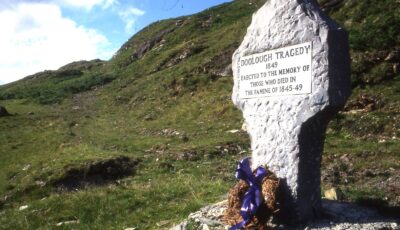The Doolough tragedy refers to a dark chapter in Irish history at the time of the Great Famine. It remains engraved in Ireland’s collective memory as a poignant testimony to the suffering endured by the Irish people, as the country was devastated by a vast blight epidemic. A look back at a terrible tragedy that left an indelible mark on Ireland…

{%CAPTION%}
The event takes place in 1849, in the wild, remote landscape of Doolough, County Mayo.
At that time, the whole of Ireland was affected by the Great Famine.
Since the start of this unprecedented crisis, the population has suffered considerable losses, caused by malnutrition, poverty and disease. Many desperate Irish people are asking for help and suffering mass deaths.
England, which was administering Ireland at the time, was surprisingly inadequate in managing the crisis. It provided relative assistance to the Irish and treated the Famine as a simple case of natural disaster, exacerbated by local economic problems, rather than as a humanitarian crisis requiring massive intervention.

{%CAPTION%}
The Doolough tragedy began on March 30, 1849. Two British officials from the Poor Law Union travel to Louisburgh.
Their mission is simple: to receive the Irish people most affected by poverty, and to decide whether or not to continue providing aid to help them survive.
Hundreds of starving Irish people from remote areas turned out en masse in a desperate march to be received by these officials. These exhausted souls, made up of men as well as women and children, travel long distances, facing cold and hunger, in the hope of receiving help in the form of food or work. Their destination is Louisburgh, where officials must decide their fate.
However, for some unknown reason, the officials do not receive anyone at Louisburgh. The exhausted Irish find the doors closed and learn that the British officials have taken up residence at Delphi Lodge, a hunting lodge lost in the middle of nowhere, 20km south of the town.
The Irish people concerned are then instructed to present themselves here at Delphi Lodge the following day at 7.00 a.m. sharp, to have their situation checked.
An ill-considered request! With no other choice, hundreds of Irish people had to get back on the road immediately, in the hope of reaching the new rendezvous point on time.
Exhausted, they set off along the Doolough Valley road in extreme conditions. The storm is raging: it’s pouring rain and the cold is biting.
They progress through majestic and precarious landscapes until late at night to cover these 20km (mostly on foot), when they are already in an advanced state of weakness and malnutrition.
All the conditions are in place for a dramatic outcome.
The next day, the toll was terrifying: on the road to Delphi Lodge, the lifeless bodies of numerous Irishmen were found. Men, women, children… The losses are considerable, caused by hunger and exhaustion!
Initially, the local newspaper “The Mayo Constitution” reported 7 dead and 9 missing… A far-fetched estimate, since it was estimated a few days later that the night had caused the deaths of more than 400 Irish people!
At the time, the events at Doolough were a scandal. Many Irish people criticize the thoughtlessness and negligence of British officials, who have forced hundreds of weakened Irish people to travel insane distances to meet them.
These officials will never be convicted for their actions.
At the time, the British government’s response to the famine was often criticized by the Irish for its softness, inadequacy and lack of compassion… An attitude that is largely the result of the dominant economic and political philosophy of the time, notably laissez-faire and attitudes towards poverty.
The lack of reaction on the British side helped to reinforce Irish anger towards the British Empire. A strong sentiment that exacerbated Irish nationalist tendencies.

{%CAPTION%}
So this tragic march became a symbol of Irish suffering during the Great Famine. Thousands perished, not only in Doolough, but across the country, victims of hunger, disease and neglect.
Today, Doolough has become a place of remembrance for those who lost their lives.
The annual commemoration in Doolough, known as the Famine Walk, attracts people from all over the world, united in remembrance of this dark period. This symbolic pilgrimage retraces the steps of the hungry, offering an opportunity to reflect on the themes of social justice and solidarity.
By walking this path, participants pay homage not only to the victims of the Great Famine, but also to all those who, throughout history, have suffered from poverty and exclusion.
The Doolough tragedy is a reminder of the importance of remembering the past to avoid repeating the same mistakes. It also underlines the resilience of the Irish people, capable of overcoming incredible hardships and building a better future, by remembering the lessons of the past.